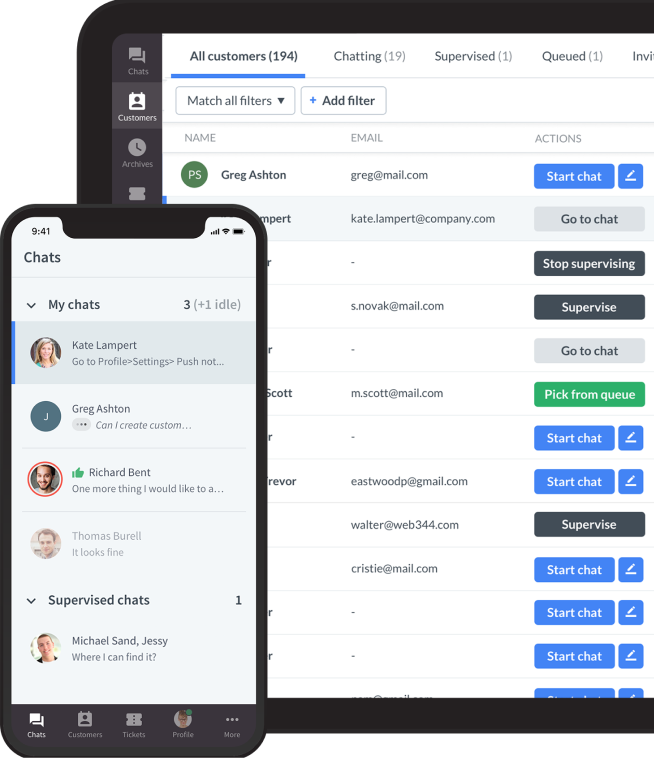Showing top 0 results 0 results found
Showing top 0 results 0 results found

You feel like there's no reason to complain about your sales reps' results, but deep down, you know they could be closing more deals. The revenue is off the charts one month, only to be off the mark the following month.
This can happen because of poor communication between your marketing and sales team, focusing on operational efficiency instead of long-term strategy, or leaving too much of your success to luck.
A proper sales process will help you remove all these hurdles and pave your way to success.
The six stages of a typical sales process
The key stages of the sales cycle create a roadmap you need to follow as you guide prospects in the sales funnel from initial contact to closing the deal and beyond.
Prospecting
This initial stage of the sales process involves identifying potential customers interested in your product or service. Research your target audience to create a list of prospects and their needs and pain points. You can find them engaging in online communities like subreddits built around your industry or reading online reviews of your competitors. If you're a sales rep, this will help you find topics to discuss once you eventually start sales prospecting.
Also, pay attention to demographics, firmographics, and buying habits to get a sense of what types of prospects have the highest chance of converting and what are the best ways to engage them. You'll avoid wasting time chasing prospects with little to no chance of becoming your customers.
Qualification
Once you've identified potential customers, ask open-ended questions to better understand the needs and motivations of a prospective buyer, determine if they are a good fit for the product or service, and how to best position your offering.
This involves assessing the prospect's needs, budget, and decision-making authority. Use qualification frameworks like BANT (Budget, Authority, Need, and Timeframe) or CHAMP (Challenges, Authority, Money, and Prioritization) to guide your qualification process.
To better use your time, assign a score to qualified leads based on their qualification criteria. This lead scoring system will help you prioritize your efforts and focus on the most promising opportunities. Start working on high-potential leads and disqualify poor fits to maximize your productivity.
Presentation
In this stage of your sales process, showcase your product or service to qualified prospects. Craft a compelling sales pitch that highlights the benefits and features of the offering and demonstrates how it can solve the prospect's problems.
Tailor your presentations to the specific needs and interests of each prospect. This personalization makes the pitch more engaging and relevant to the audience. Use visual aids like slides, videos, or product demonstrations to make the presentation more dynamic and help prospects better understand the offering.
On top of that, weave some storytelling into your offer to capture a prospect's attention and make your presentation more memorable. You can do this by using real-world examples, business analogies, and case studies that illustrate the benefits of your product or service.
Handling objections
The more money people have to spend, the more concerns and doubts they'll have about your product or service. Anticipate common objections and prepare responses in advance to address concerns by empathizing with the prospect and providing a well-reasoned response.
Validate the prospect's concerns and provide a solution or counterargument, demonstrating empathy and understanding. This will help you build trust and authority, showing the prospect that spending their money with you is better than the competitors.
Deal closing
This is your time to shine, the moment when you ask for the sale. Use persuasive techniques to encourage the prospect to decide and finalize the deal. While you do that, be aware of closing signals like verbal cues or body language that indicate the prospect is ready to make a decision. By recognizing these signals, you'll time your closing efforts effectively.
Select a closing technique that best fits the prospect's needs and the sales situation. Some common closing techniques include the assumptive close, the alternative choice close, and the summary close.
If you don't hear from a prospect for a while, follow up on those stalled deals. The prospect may be hesitant to make a decision, so follow up with additional information, reassurance, or incentives to address any remaining concerns and encourage them to move forward.
Follow-up
The sales process doesn't end once the deal is closed. Maintain a strong relationship with customers through regular follow-ups to get repeat business, referrals, and positive reviews.
Make sure that customers receive adequate support after the sale. Provide training and keep answering questions and any concerns that come your way. By keeping customers happy, you can get a valuable source of new business once they spread the word about your service. Don't hesitate to ask for referrals and encourage customers to share their positive experiences with others.
On top of it all, this ongoing communication can create opportunities for upselling, cross-selling, or future business.
How to customize your sales cycle
While building a structured sales process is essential for sales professionals to work to the best of their abilities, it's equally important to tailor the cycle to your company's unique product offerings, target market, and sales team structure.
Product offerings
Different products or services require different sales approaches. Customize your sales process according to the specific features and benefits of your offering. Products with a more complex or technical nature may require a longer sales process and more in-depth presentations to educate prospects.
Also, make sure to adjust the sales techniques you'll use. Some products or services may benefit from a consultative sales approach, while others may require a more direct, transactional approach.
Target market
Your target market plays a significant role in shaping your sales process. Understand your audience's preferences, buying habits, and pain points to craft a process that resonates with them.
Break down your target market into segments based on shared characteristics, such as demographics, firmographics, or behavioral traits. This segmentation will allow you to tailor your sales process to each group's specific needs.
Ultimately, personalize your approach by crafting messaging and sales materials that speak directly to your audience to increase the effectiveness of your sales processes.
Sales team structure
The size and structure of your team can impact your sales process. Adjust your process to align with your team's capabilities and resources. Assign specific roles and responsibilities to your sales team members based on their strengths and expertise. This division of labor will help streamline your sales process and ensure that all sales stages are handled effectively.

As your business grows, your sales flow may need to adapt to accommodate an expanding team. Establish an effective sales process that is scalable and easily modified as needed. This way, you'll avoid unnecessary interruptions in your sales cycle that often result in lost sales opportunities.
How to optimize your sales process
With an established structure and some customization, your sales process will run like a well-oiled machine. All machines require regular maintenance and fine-tuning to keep bringing their A-game, and it's no different in this case.
Leverage data analytics
Data analytics provide invaluable insights into your sales process. By analyzing metrics like lead conversion rates and sales cycle lengths, you'll identify ways to turn more of your prospects into paying customers in less time.
Establish a set of key performance indicators (KPIs) to measure the effectiveness of your sales flow and monitor these metrics to identify trends and areas for improvement. Use the discovered insights to make informed decisions about your sales process, implement changes based on the data, and continually reassess their impact.
Implement sales enablement tools
Sales enablement tools like customer relationship management (CRM) systems and sales automation software can streamline your sales process and improve efficiency. Invest in the right tools to support and help your sales team succeed.
Use a CRM system to centralize and manage all customer data so that it's easily accessible. This information will help your team better understand customer needs and improve their sales efforts.
Sales automation software will save you a ton of time by automating repetitive tasks like email follow-ups or lead nurturing. This will free up your team to focus on more strategic activities like relationship-building and closing deals.
Conduct regular sales training
Regular sales training is crucial for keeping sales teams up-to-date on best practices, product knowledge, and industry trends. Identify areas where your team could benefit from additional training — communication skills, negotiation tactics, or product knowledge — and provide training resources and workshops to help your team develop these sales skills.
Encourage your team to stay informed about anything happening in your industry, competitor activities, and emerging technologies, and discuss these topics during sales meetings to ensure your team remains knowledgeable and adaptable.
Align sales and marketing efforts and incorporate customer feedback
Sales and marketing teams should work collaboratively to ensure a seamless customer experience. Build a sales methodology with marketing campaigns and initiatives in mind, and share insights and feedback between the two departments to improve both strategies. This will make your customer communication more coherent and make the transitions from prospects to leads to customers much smoother.
How to overcome common sales process challenges
Every sales process faces challenges and obstacles. Below are some common hurdles and advice on how to overcome them.
Build relationships
Establishing good relationships with prospects is crucial for successful sales. Prioritize rapport-building and maintain consistent communication. Invest time in getting to know your prospects and understanding their needs, and be responsive and attentive to their concerns.

Communicate effectively
Installing live chat on your website is one of the best ways to communicate more effectively. Sensorem, one of LiveChat's customers, realized that too many sales opportunities were falling through the cracks. Their entire sales process lacked a system that would let them reply to their customers' messages when Sensorem's team wasn't online.
Implementing LiveChat on their website set off a snowball effect. Starting from a 10% increase in customer satisfaction, they also noticed a 5% uptick in both average contract length and customer lifetime value, which ultimately resulted in a 20% monthly revenue growth.
Improve time management
Effective time management is crucial for maximizing sales productivity. To stay organized, prioritize your tasks and try using time management tools. Focus on high-impact tasks that directly contribute to closing deals and building relationships. Use tools and techniques like time blocking or the Pomodoro Technique to control your time better.
Manage sales pipeline
Maintaining a healthy sales pipeline is essential for sales success. Regularly review your pipeline to identify bottlenecks, stalled deals, or opportunities that require additional attention. With a CRM system in place, tracking your sales activities and ensuring your pipeline remains up-to-date and accurate will be easier.
Stay motivated
Sales can be a challenging and demanding profession. Keep your sales reps motivated by setting realistic sales targets, providing regular feedback, and celebrating achievements. Foster a supportive and positive work environment that encourages collaboration and continuous improvement
It’s time to polish your sales process
Whether you track all your sales in a good old Excel file or use some sophisticated software with all the bells and whistles you can imagine, remember that even the basic sales process is better than improvisation. Opt for the latter, and you'll eventually end up in trouble — even if you're on a streak of landing a client one after another.
And as you work on each stage of your sales process, remember that the best thing you can do for your sales performance is to talk to your customers. They hold the key to the success of your business.








Comments